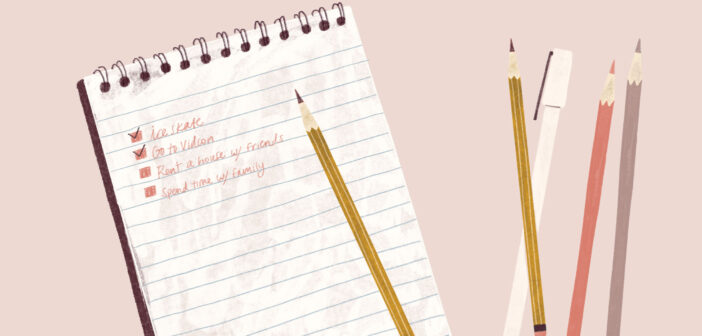Close your eyes. For a year, we have been together in a dark tunnel, each of us imprisoned in individual caves. Occasionally, we see a flash of light. A friend through a computer screen. An outing to the grocery store. But in the end, these flashes of light are temporary, and only result in blinding us after they have passed.
Yet over the horizon, the sun begins to rise, and the thinnest of rays have crept like silent lions into the tunnel. Our eyes slowly adjust to these changes and hope leaps in our hearts. The dreams we had in the dark, our aspirations and hopes, are nearly close enough to become solid plans — to become reality.
Courtney Kurhayez, ‘21, is hopeful. Her post-COVID checklist is short and simple. It was all the things that she was planning on doing regardless of COVID. Yet somehow, the denial of opportunity made her miss normalcy all the more. “There’s a lot we took for granted before,” Kurhayez said. “We are now more aware, or cognizant, of the things we can’t do.”
Kurhayez has a list of everything she wants to do after COVID. She wants to ice skate, go to VidCon and rent out the house from the “Twilight” saga with friends. Most of all, she wants to spend time with family and celebrate all that happened throughout the year.
“My grandma always talks about having one big party after COVID, for all the billion things,” Kurhayez said.
And although many are optimistic that the end of the pandemic may be near, “We don’t even know when it’s gonna be,” Kurhayez said. “It’s weird because post-Covid is going to be post-graduation for us … our lives are never really going to go back to normal college.”
A New York Times article titled “What’s the First Thing You Will Do When the Pandemic Ends” collected responses from over 800 people. Some had dreams to travel the world, but most longed for simpler times. One reminisced on the simple gesture of shaking hands. Others wished to be able to hug and kiss their loved ones. Some yearned to go dancing, to the library or to the movie theater.
Rebekah Eaton, ‘22, also has an attainable post-COVID checklist. For her, going to the beach in California and attending concerts again is what she looks forward to the most. As an introvert, Eaton has adjusted well to the changes that came with COVID. Even the masks have been “very helpful in the wintertime,” Eaton said. For her to feel comfortable going out in public, though, “most people … have to be vaccinated.”
“We’ve had lots of epidemics,” said Ann Keating, Dr. C. Frederick Toenniges professor of history, but there are far fewer now than in earlier years, where cholera, tuberculosis, typhoid, smallpox and Spanish flu devastated communities.
“If you go back to 1918 through 1919 you’ve got a pandemic that bears a lot of similarities to the one that we’ve got right now.” Wearing masks, social distancing and outside gatherings were encouraged. Although it is unlikely most of these were mandated, according to Keating, some rules, such as mask-wearing on public transportation, were required. “They outlawed spitting and smoking on trains,” Keating said.
There was a big spike of Spanish flu in the fall of 1918. “And then it just kind of peters out. The assumption is that we hit some kind of herd immunity,” Keating said.
Communities, rather than states, made the call to shut down. Theaters, saloons and schools in Chicago closed. However, instead of month-long shutdowns, these closings were often several days at a time when the sickness got worse.
There were three rounds of Spanish flu. The spread of it was mostly due to the soldiers in WWI as they moved about. When the flu came to Naperville, most likely transferred by soldiers from Fort Sheridan in Chicago, Goldspohn became a field hospital.
The population at NCC dropped, partially due to the number of young men signing up for the war, and partially due to the flu. Resident students who got sick usually had their parents come to nurse them back to health.
“They played football in the fall,” said Keating. “They had trouble fielding a team some games because they had so many kids that were sick. “There’s an attempt to go on normally,” Keating said of the sport’s continuation.
The largest difference between history and COVID-19 is that we have a vaccine, Keating said. “The terrifying thing to me is that when … I started looking more carefully at 1918–19 in Chicago … when they said 675,000 deaths in the United States, I’m like, ‘We’re never going to hit that number’ … it’s sobering and terrifying to me how close we are.”
With precautions in place and the vaccine currently in distribution, experts hopefully predict the U.S. will receive herd immunity sometime this year.
“The end of this story is a different one,” Keating said. “We’re going to get herd immunity, but it doesn’t have to end with everyone getting sick.”
Keating is hoping to be back in classrooms in the fall, especially so she can take her Chicago history class into the city for field trips.
There are many things Keating hopes to do after the pandemic has ended. “Going to the grocery store and not worrying about this, oh my God, going to a RESTAURANT, oh, not doing takeout,” Keating laughs, “Not doing dishes after we eat!” Most of all, Keating misses being able to talk to her students, co-workers, family and friends.
The world is ready to be normal. With wishes for brighter days and sans-mask smiles, with post-COVID checklists anxious to be ticked off, with expectations, we move forward.
“God, I’m hopeful,” Keating said.

